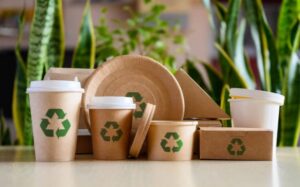Sustainable Packaging Boxes
Creating sustainable packaging boxes can increase brand loyalty, expand your audience, and leave a positive impact on the environment. Many consumers are willing to pay more for products that are environmentally supportive.
Corrugated
 Corrugated packaging provides excellent structural rigidity and cushioning qualities for products shipped to ecommerce customers. It is also highly customizable and can be printed with branding, product information, or even promotional messages. This makes it a great choice for CPG companies looking to increase brand awareness and drive sales. Corrugated is an environmentally friendly material, and it can be recycled multiple times. Its fibers are repurposed and returned to the manufacturing process to make new boxes, which makes it an ideal choice for green packaging initiatives.
Corrugated packaging provides excellent structural rigidity and cushioning qualities for products shipped to ecommerce customers. It is also highly customizable and can be printed with branding, product information, or even promotional messages. This makes it a great choice for CPG companies looking to increase brand awareness and drive sales. Corrugated is an environmentally friendly material, and it can be recycled multiple times. Its fibers are repurposed and returned to the manufacturing process to make new boxes, which makes it an ideal choice for green packaging initiatives.
Corrugation is a process in which layers of paper are pressed together and steamed. The result is a wavy sheet that can be cut into shapes to create cartons or shipping boxes. The sheet is then laminated with plastic or foil to provide a barrier against moisture and other contaminants. There are many options available for printing on corrugated, including digital, flexographic, and offset.
The primary raw materials for making cardboard and corrugated are wood and pulp. Pulp is a fibrous product that can be made from recycled or virgin chemical fibers. The primary types of pulp used in the manufacture of paper and cardboard are white or brown, kraft, and recycled. The paper and cardboard are then combined with other materials such as glue, ink, and plastics to make the final products.
Whether you’re designing for food, beauty, or consumer electronics, you can find a wide selection of sustainable packaging materials to fit your needs. Corrugated can be designed to accommodate heavy or fragile products and can include custom molded inserts for extra protection. It’s also a popular choice for shipping medical equipment and supplies because of its rigidity and cushioning properties.
The corrugated box industry has created a wide range of fluting sizes that can be tailored to your specific shipping requirements. For example, Type B cardboard is more rigid than Type A and offers compression strength while still providing excellent printability. Type E fluted corrugated is thinner and has almost double the number of flutes per linear foot for added stability and strength. For more information about the sustainable packaging boxes, click here.
If you’re considering switching to sustainable packaging, start by ordering small quantities of your new materials. This will allow you to assess durability, customer reception, and overall performance compared to your old packaging. Then, you can slowly replace your existing supplies with the new sustainable packaging until you’ve completely switched over.
Glassine
Glassine is a paper-based material that is both biodegradable and fully recyclable. It is also resistant to water, grease and air, making it an ideal option for food packaging. However, it is not as durable as plastic, and it should only be used for short-term storage. It can be purchased in sheets of varying sizes, rolls of 36”- 60”, and pre-made envelopes. Its neutral pH and acid free status make it a good choice for the preservation of flat materials such as negatives, photos, stamps and documents. It can be made opaque by adding dyes during the pulping process, but it is mostly used in its transparent form, as it enables users to see what is inside.
Like standard paper, glassine is made from wood pulp and can be recycled many times before losing its strength. It is also a sustainable material because it can be grown and harvested without harming the environment. Additionally, it is a renewable resource, and it can be remade into new products more than 26 times before it degrades.
The first step in making glassine is to chip and cook the wood into pulp. This breaks the chemical bond of the lignin and allows the pulper to separate the cellulose. Lignin is the part of the tree that holds fibers together, but it is removed during the pulping process so that paper can be made. The cellulose is then pressed between hard pressure cylinders known as calendars. Glassine is different from regular paper because it goes one step further and undergoes a process called supercalendering. This process changes the cellulose on a cellular level, which makes it more resistant to moisture and grease. It is also much smoother and glossy than standard paper, and it does not shed when it comes into contact with other items or surfaces.
Cellulose
Cellulose is a polymeric carbohydrate that is found in the cells of plants and is also used to make paper, textiles, and plastic. It is one of the most common organic compounds on earth and has the chemical formula (C6H10O5)n. Cellulose is a non-toxic and biodegradable material, and it can be easily recycled. It is a sustainable alternative to plastic packaging. For more information about the sustainable packaging boxes, click here.
